Basic Sopaipilla Recipe (New Mexican Sopapillas)
30
Updated Nov 03, 2024, Published Apr 23, 2022
This post may contain affiliate links. Please read our disclosure policy.
New Mexican Sopaipillas (sometimes spelled “sopapillas”) are deliciously fried pastries that are easy to make with just a handful of simple pantry ingredients. Serve them drizzled with honey or sprinkled with cinnamon sugar for a sweet treat, or stuff them with your choice of savory filling for a complete meal.
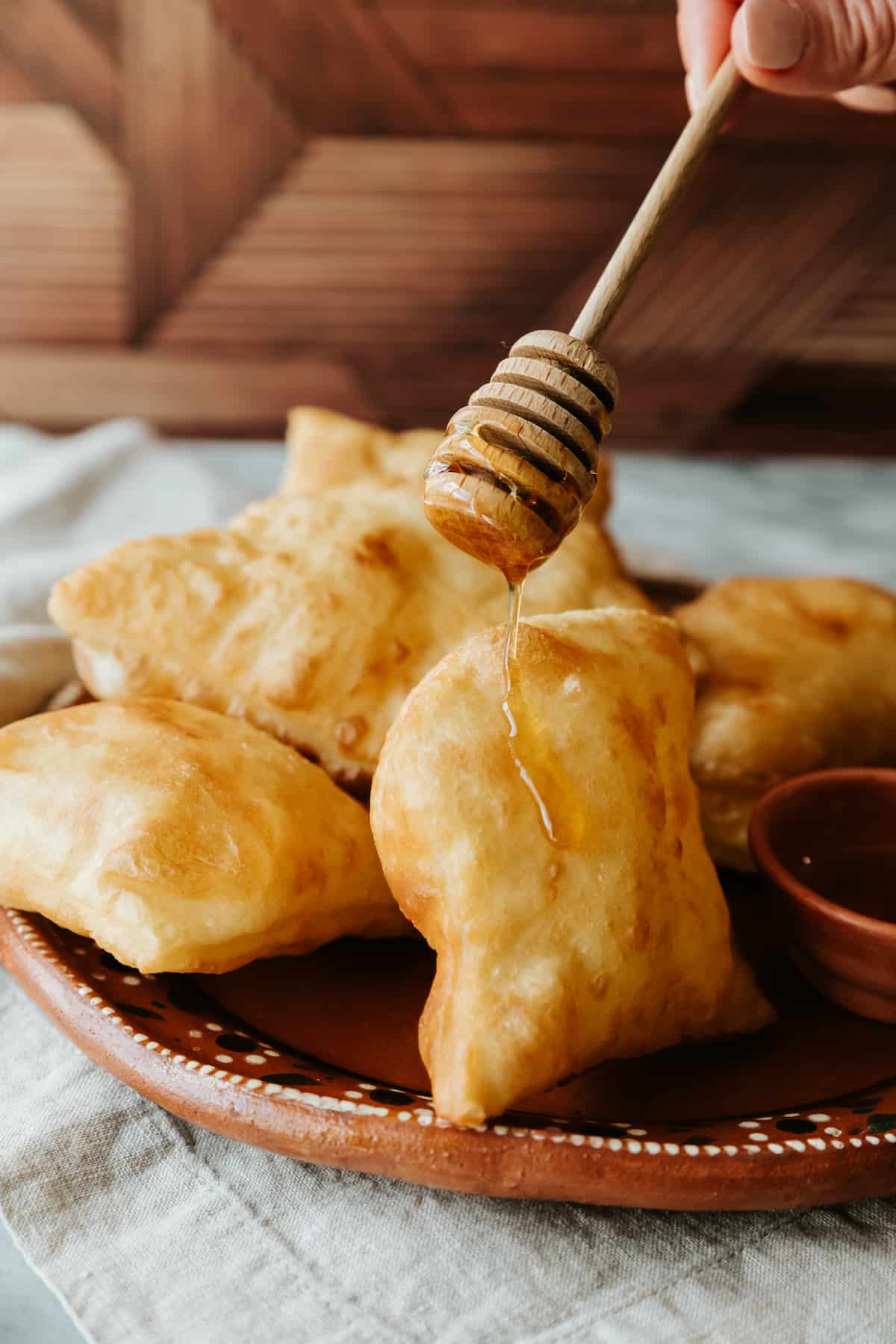
Growing up as a Mexican-American in El Paso, Texas, this easy sopapilla recipe has always been near and dear to my heart. My dearly departed Abuela Jesusita used to make these warm, puffy fry breads often, and though they can swing sweet or savory, she generally considered sopapillas dessert.
I loved them so much that her recipe is in the Muy Bueno cookbook, and today I am sharing it here on the blog along with a video of me making sopaipillas.
Table of Contents
- What are Sopapillas?
- Why You’ll Love This Recipe For Sopaipillas Mexicanas
- Ingredients & Substitutions
- How to Make Sopapillas
- Optional Variations
- Serving & Topping Suggestions
- Expert Tips & Tricks
- Storage & Heating Instructions
- Frequently Asked Questions
- More Tex-Mex Dessert Recipes
- New Mexican Sopaipillas Recipe
What are Sopapillas?
Sopaipillas are pieces of deep-fried dough that are popular in regions with large contingents of Spanish settlers. They’re quite popular in Northern Mexico, especially in Chihuahua where my abuela was born, as well as in other Latin American countries, New Mexico, and Texas. In fact, they are so popular here in the US that my home state of Texas named sopapillas the official state pastry in the early 2000s.
While the specific history of this delicious treat isn’t entirely clear, some speculate that it is related to other fried food like Native American fried bread, Mexican churros, and Spanish sopaipas. The New Mexican sopaipillas that originated in Albuquerque are therefore a delicious snapshot of the diversity of the southwestern US in the 1800s!
In New Mexico (and in many South American countries), they can be served as either a savory meal or as a dessert. Tex-Mex sopapillas are made the same way as New Mexican sopapillas, but in Texas, they’re always dessert.
It’s also important to remember that multiple versions of this delicious fried pastry exist. Sopaipillas from Argentina, Chile, Peru, and Uruguay are a bit different from the New Mexico sopapilla recipe I grew up with, and are generally more like thin fried flour tortillas than puffy fry bread.
Interestingly enough, New Mexico sopaipillas have become such a beloved dish across the southwest United States that some parts of Northern Mexico will serve them, though they aren’t truly Mexican. (For reference, Mexican cuisine’s closest approximation would be buñuelos.)
Why You’ll Love This Recipe For Sopaipillas Mexicanas
- Economical and easy: They’re made with only 6 ingredients, one of which is water. In other words, they’re super simple and inexpensive!
- No fancy equipment needed. You don’t need any special equipment to make these gorgeous fry breads; all you need is a rolling pin, a deep sauté pan, and about 30 minutes of active time in the kitchen.
- Versatile: You can serve these homemade sopapillas as lunch, dinner, or dessert!
Ingredients & Substitutions
The complete list of ingredients, quantities, and instructions can be found in the printable recipe card below.
- All-Purpose Flour: Plain white flour is all you need.
- Baking Powder: This leavening agent is what causes the pastries to puff up. If you’re not sure if yours is still good, add a small spoonful to a bowl and add a splash of hot water. So long as it bubbles, it’s still active!
- Salt: A touch of seasoning keeps even the plain ones (with no coating or fillings) from tasting too bland.
- Shortening: Using shortening rather than butter ensures your sopapillas are nice and soft.
- Warm Water: If possible, use filtered water for the most neutral taste.
- Canola Oil: For frying. Any other neutral oil will also work (e.g. peanut, avocado, or grapeseed), but canola is relatively heart-healthy and inexpensive making it a win-win in my book.
- Cinnamon-Sugar & Honey: These are entirely optional, but my grandma considered them essential sopaipillas ingredients. Feel free to omit them if you’re going for a savory approach!
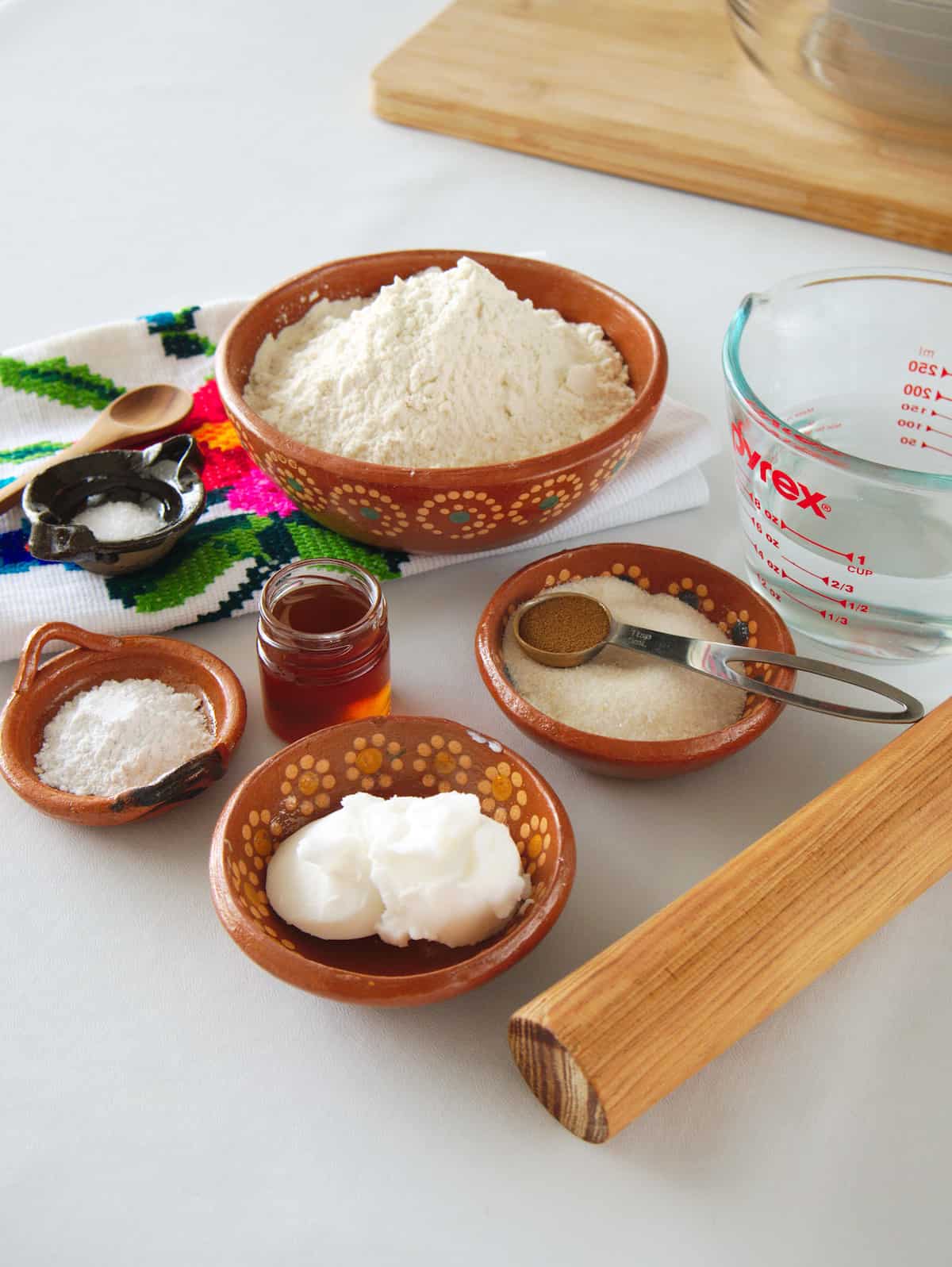
How to Make Sopapillas
Step 1: Sift dry ingredients in a large bowl.
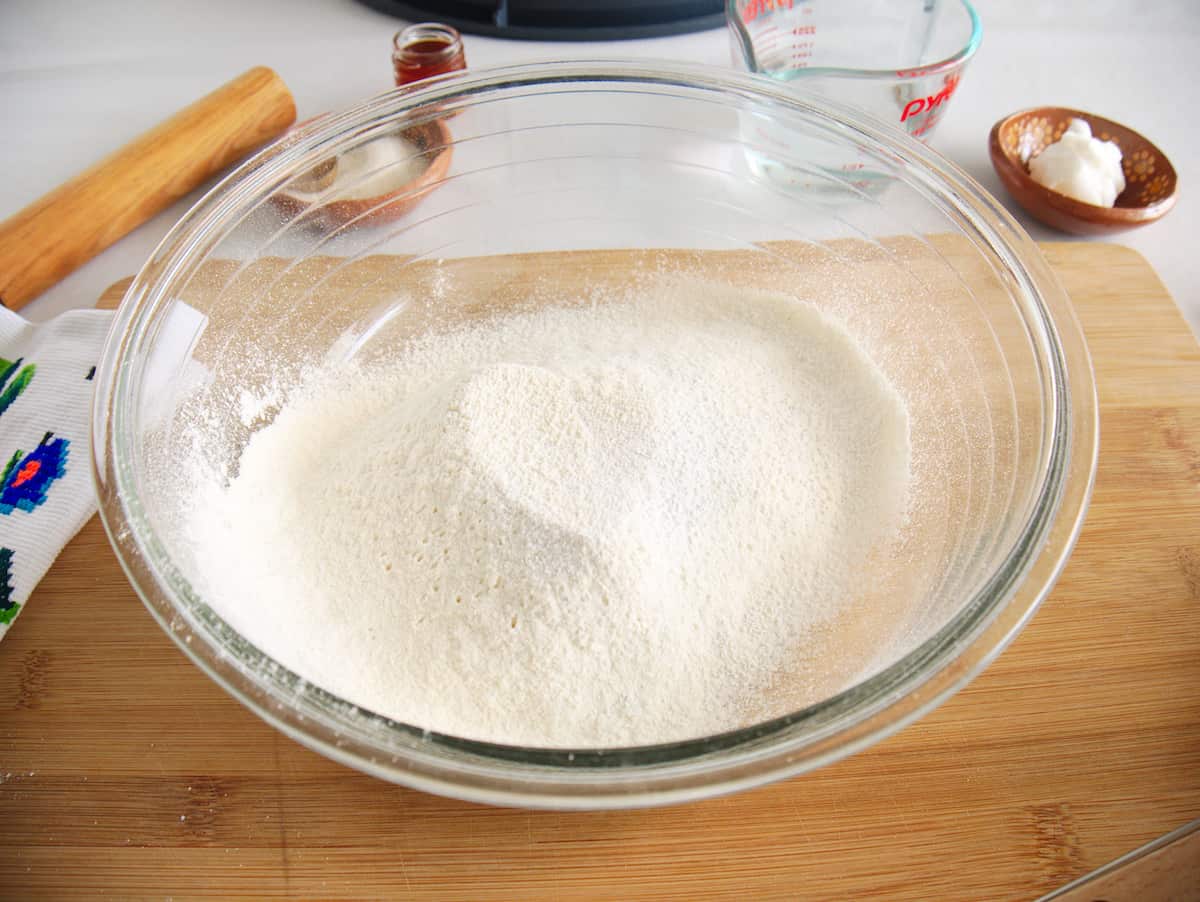
Step 2: Cut in the shortening until the mixture resembles coarse crumbs. Think of it like you’re making pie dough.
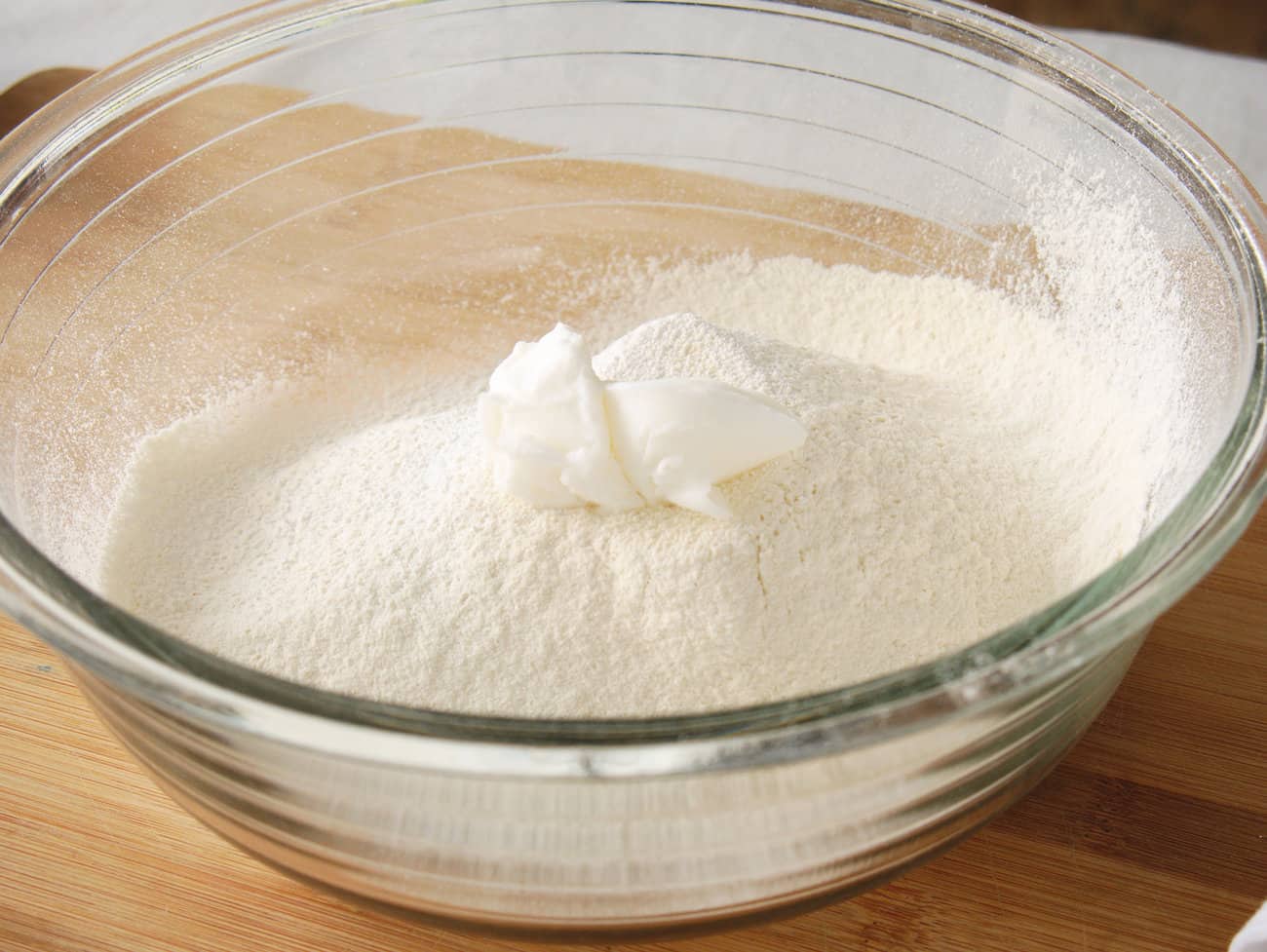
Step 3: Moisten dough. Gradually stir in warm water until the dough *just* pulls together.
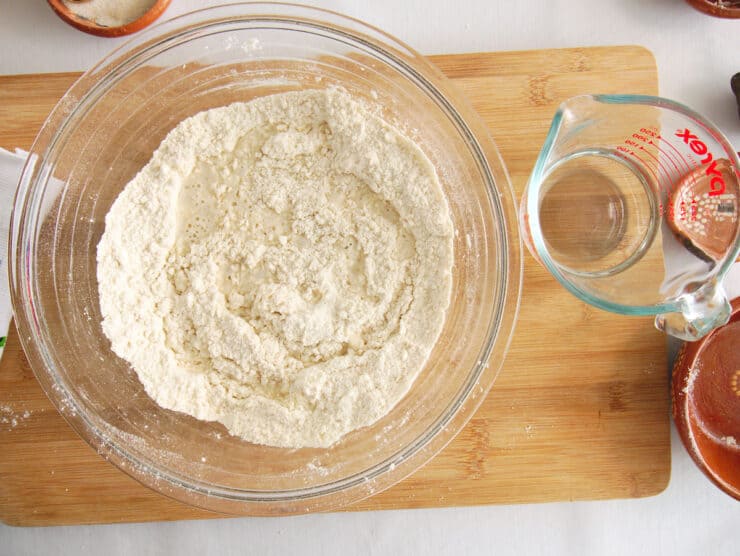

Step 4: Divide dough into 5 pieces. Roll out each piece of dough on lightly floured board into an 8-inch diameter circle. Cut each circle into 4 wedges.
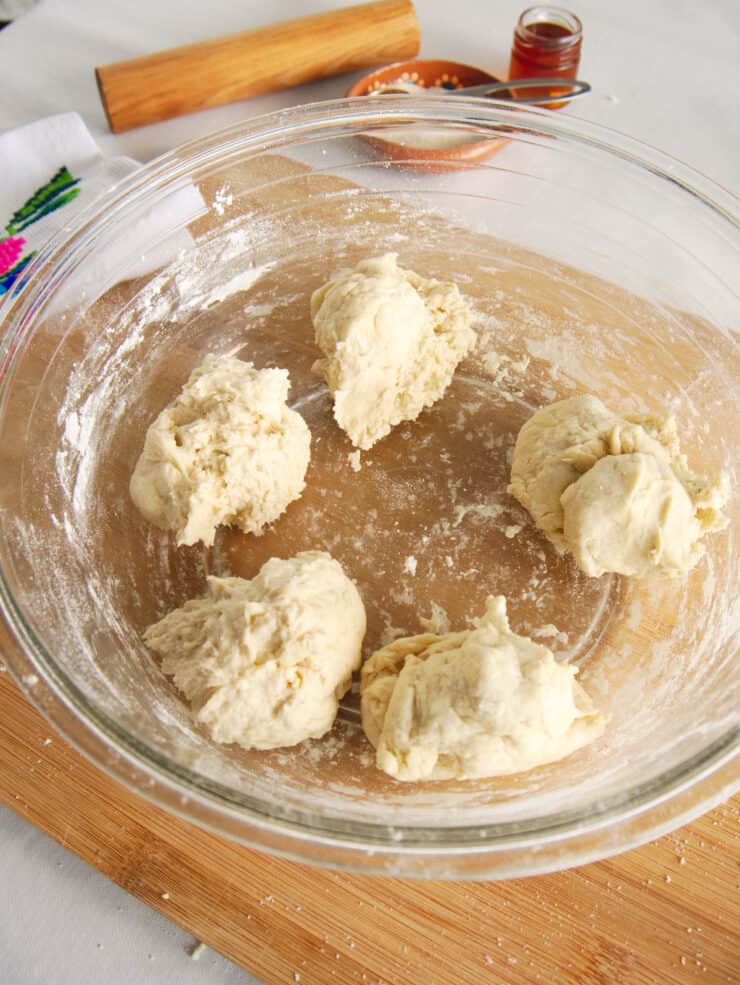
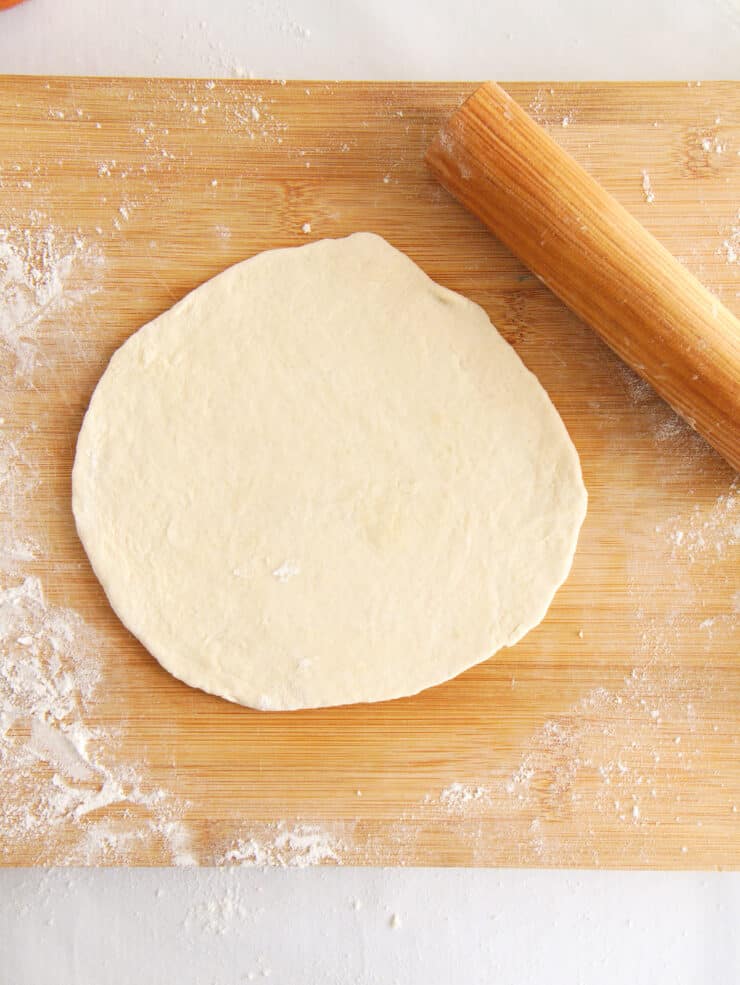
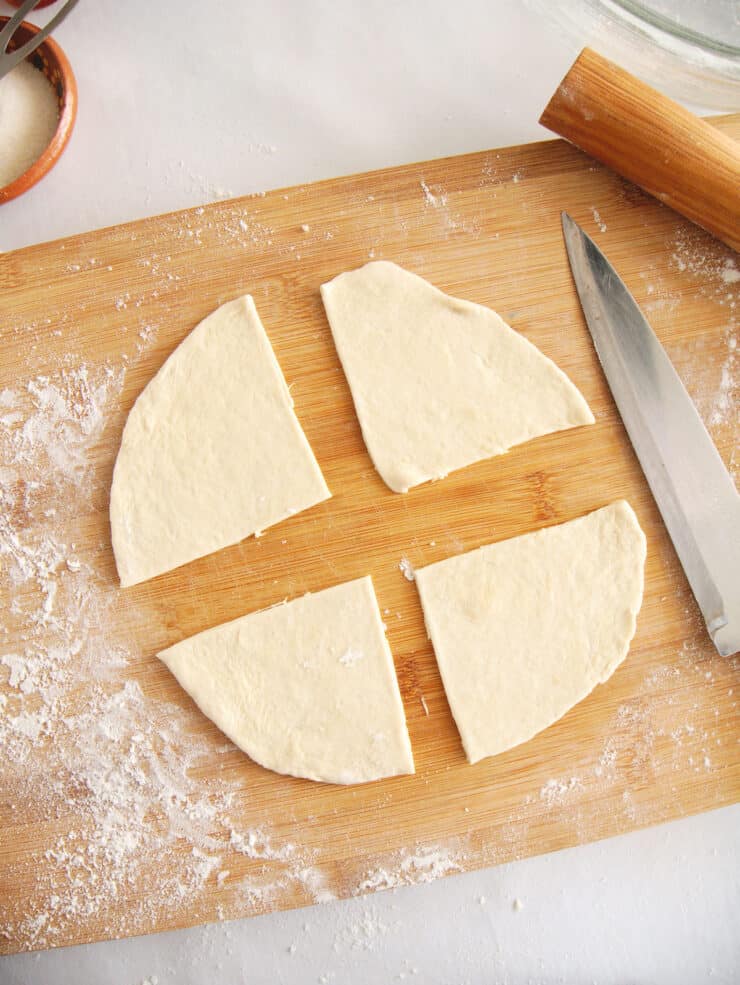
Step 5: Fry. Heat oil in a deep frying pan until it reaches 350-365F. Working in batches, add a few of the dough wedges. The wedges will puff up. Turn once so they puff evenly on both sides, then turn back to brown evenly on both sides.
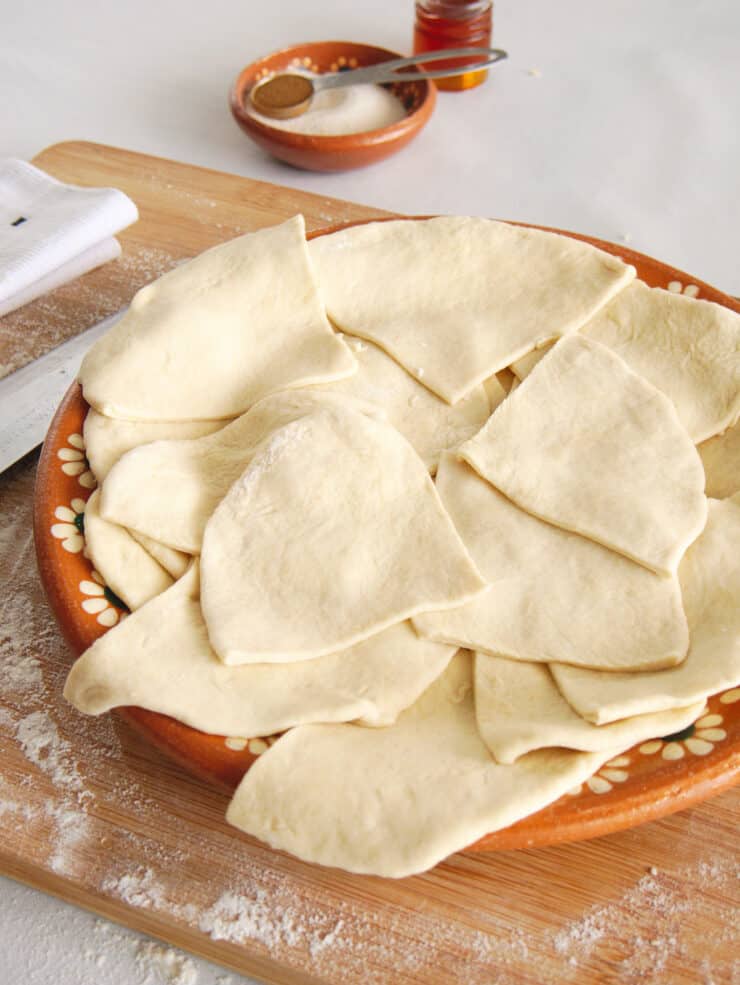
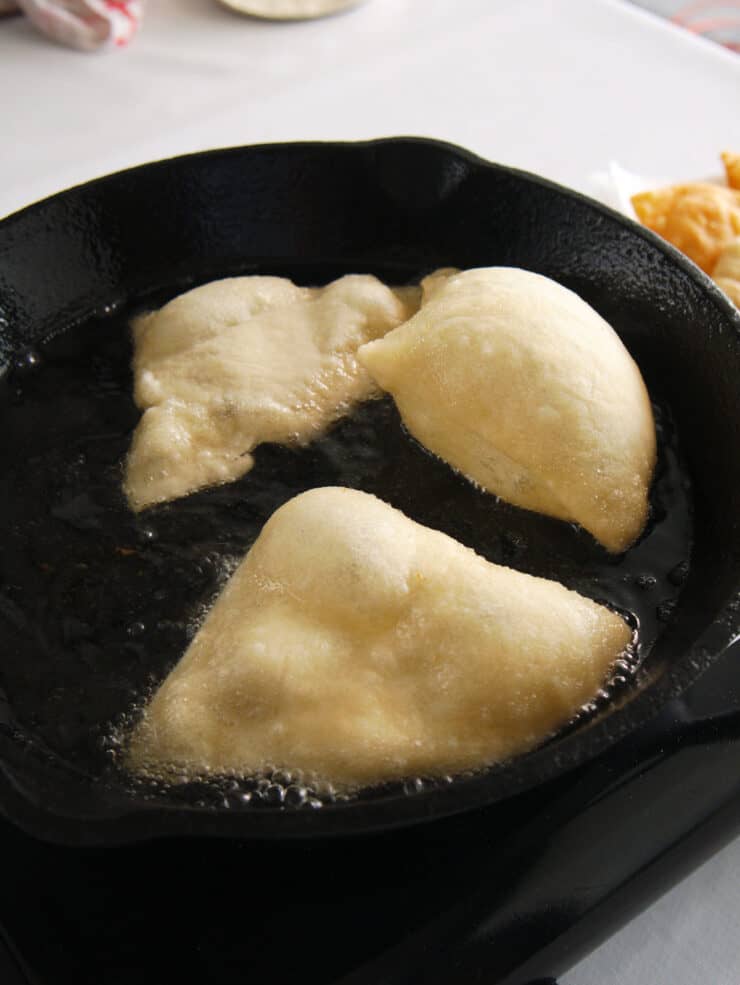
Step 6: Drain. Remove each fried sopaipilla to a plate lined with paper towels to drain excess oil. Repeat steps 5 & 6 until all the dough is fried.
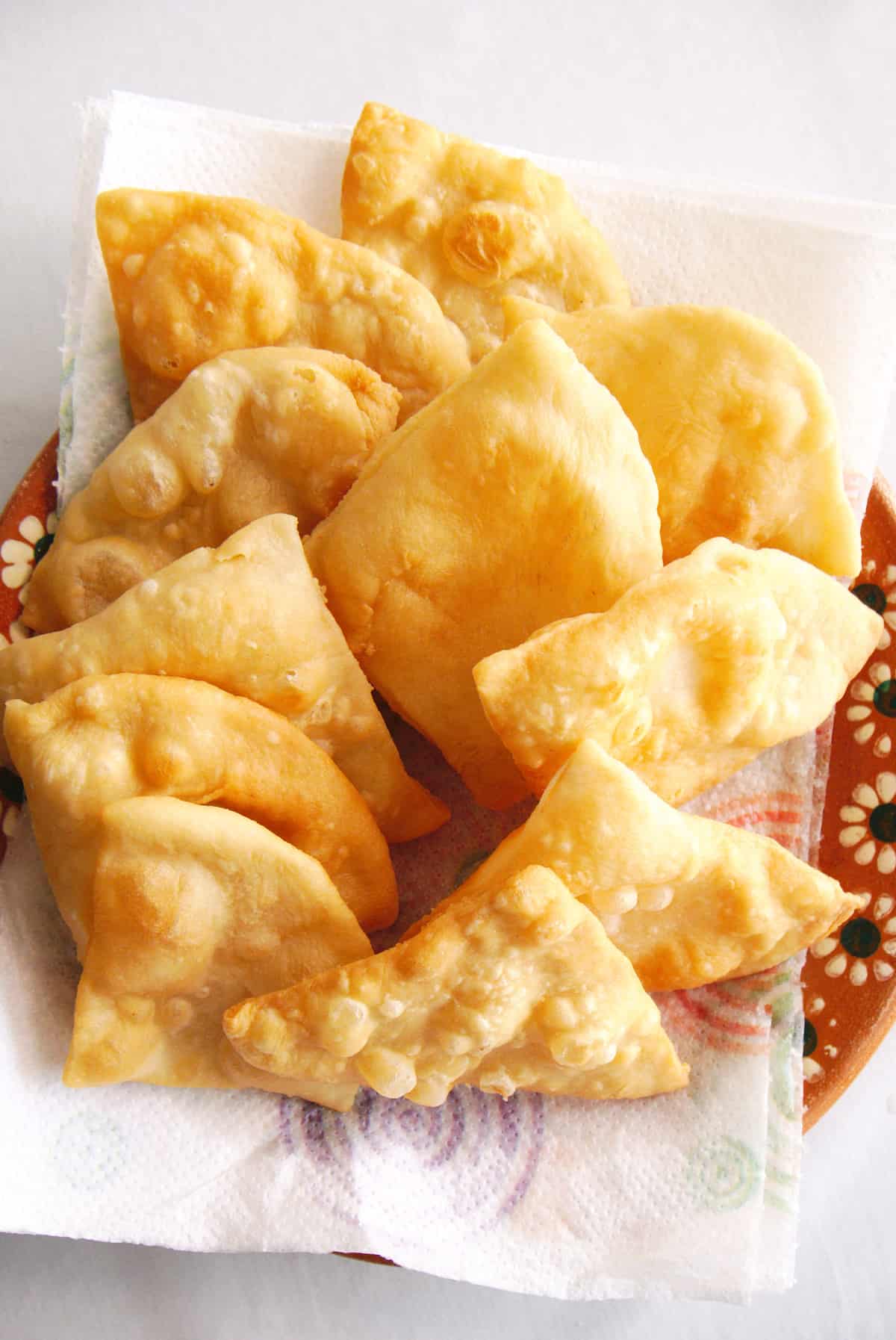
Step 7: Add seasoning (e.g. cinnamon sugar or salt) while the sopaipillas are still warm. Serve immediately!

Optional Variations
As much as I love my family’s sopaipillas recipe, there are a few ways you can make it your own. Here are some ideas to get you started:
- Gluten-Free Sopapillas: Swap in your favorite cup-for-cup gluten-free all-purpose flour blend (preferably one with xanthan gum). Allow the dough to rest for 30 minutes before shaping and frying to allow the flour time to properly rehydrate. If you skip this step, you’re likely to get a grainy consistency.
Serving & Topping Suggestions
Sopaipillas are amazingly versatile, working in either sweet or savory applications. Once fried, either toss with the seasoning mixture of your choice, stuff them like a pita pocket, or drizzle with sauce. YUM!
Savory Sopapillas
You can eat sopaipillas with any number of savory fillings, including spicy carne adobada, potato and ground beef picadillo, creamy homemade refried beans, or pork green chile. I find that they also pair quite well with savory dips like Tex Mex chili con 1ueso, choriqueso (queso fundido with chorizo), and classic guacamole.
Sweet Sopapillas
Of all the ways to eat them, I prefer my grandma’s favorite sopapilla dessert. I can still see my abuela sitting in her kitchen drinking her cafecito (cafe de olla) and drizzling miel virgen (honey) on a cinnamon sugar-coated sopaipilla. I always channel that memory when I make a batch!
While this is still my favorite way to eat them, they can also be served with other sweet spreads like rich Mexican chocolate dipping sauce, homemade dulce de leche, or mixed berry sauce. I also enjoy topping a hot sopapilla with ice cream, or dipping them in coffee or Mexican hot chocolate!
Do you like your sopaipillas sweet or savory? What is your favorite way to use these fried pockets of deliciousness? Let me know in the comments below!
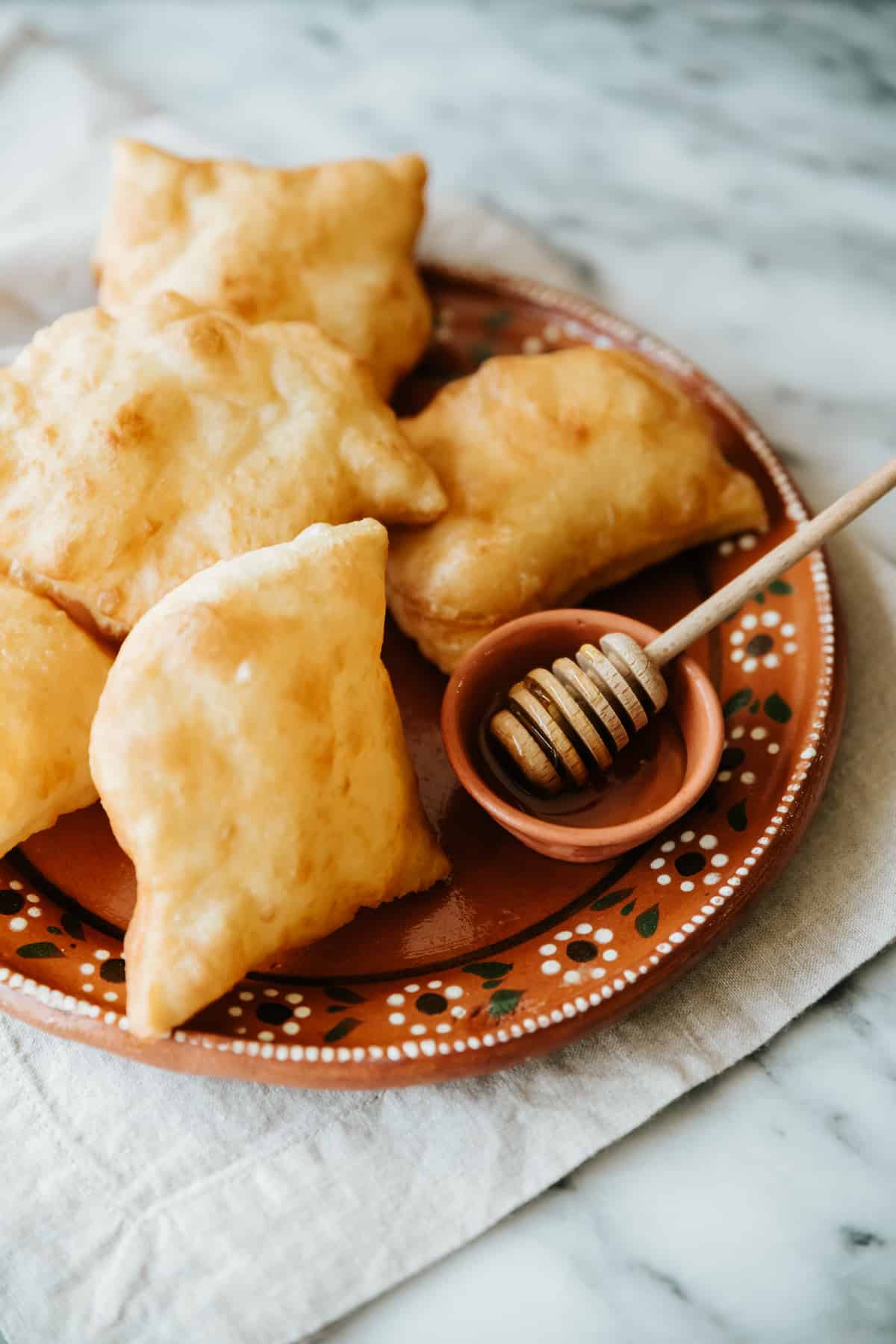
Expert Tips & Tricks
- Don’t skip draining them on paper towels — it’s what keeps them from becoming greasy. This is an essential step for basically everything that is fried.
- Sprinkle them while they’re hot. If you plan on dusting your sopaipillas in cinnamon sugar, make sure to do it while they are still warm from the fryer! They’ll be able to adhere to the mixture better when they are hot.
- Serve them warm! If you let them cool too much, sopapillas can begin to feel dense, heavy, and even greasy. If you’ve made them ahead of time, simply warm them before serving. (Instructions below!)
- If you’re planning on frying and serving them the same day, sopaipillas can be kept warm on a baking sheet in a 200F oven for up to 1 hour.
Storage & Heating Instructions
- Refrigerate: While sopaipillas are best freshly fried, you can let them cool to room temperature and then store them. They will keep well in an airtight container in the refrigerator for up to 3 days.
- Reheat: To serve, warm them in a 350F oven for 10 to 15 minutes before serving.
Frequently Asked Questions
At their core, sopaipillas are made by frying a simple, unyeasted dough.
The original concept of sopapillas came from Spain, with Moorish and Jewish influences. The Spanish called them “sopaipas,” which came from a Mozarabic word “xopaipa” which translates to “bread soaked in oil.”
Spanish colonizers brought the sopaipa recipe with them, but as it spread throughout the United States and Latin American countries, each region took the idea in a slightly different direction.
While the ingredients are the same for sopapillas as homemade flour tortillas, the proportions are different. If you were to fry tortilla dough, I’m sure it would taste great, but the consistency would be closer to a crispy buñuelo.
In Chile, sopaipillas are often made with pumpkin in the dough and are flatter than the New Mexican variety. Sopapillas pasadasare made with leftover Chilean sopapillas that have been soaked in a sauce made of molasses and orange peel, known locally as Chancaca.
New Mexican sopapillas, on the other hand, are light and puffy. They can be split open like a pita to be stuffed, whereas the Chilean variety is too flat to do this.
While both are made from fried dough, the primary difference is that beignets are usually breadier and made with yeast, whereas sopapillas are lighter, flakier, and made with baking powder.
Sopaipillas are little pillows of bliss. They are similar to fry bread that puffs up when fried until golden brown on the outside and remains soft on the inside. Sopapilla dough is also unsweetened, which means it can be used for either sweet or savory applications.
Buñuelos, on the other hand, are rolled out thin and fried until crispy. They are also always served as a dessert.
Some New Mexico and Colorado restaurants stuff sopaipillas by splitting them down the middle like pita bread and spooning in carne adobada, Mexican picadillo, or other fillings. Stuffed sopaipillas (a.k.a. sopapillas rellenas) don’t have to be savory, but they often are. In my latest cookbook, Muy Bueno Fiestas, you will find a recipe for sopaipillas stuffed with beef and beans in the Father’s Day chapter.
Ooops! Sounds like your oil wasn’t hot enough yet. Wait until it’s shimmering, or, if you want to be scientific, until it reaches between 350F – 365F.
More Tex-Mex Dessert Recipes
Did you try my Basic Sopapilla Recipe? If so, let me know how yours turned out by rating and reviewing it below. If you came up with a brilliant way to use these delectable fried pastries, be sure to tag me in your social posts so I can cheer you on!

Summarize & Save This Content On

New Mexican Sopaipillas
Ingredients
- 2 cups all-purpose flour
- 2 teaspoons baking powder
- 1 teaspoon salt
- 2 tablespoons shortening
- 3/4 cup warm water
- 1 to 2 cups canola oil for frying
Cinnamon-Sugar
- 1 teaspoon ground cinnamon
- 1/4 cup granulated sugar
- honey
Instructions
- In a large bowl, sift together flour, baking powder, and salt. Cut in shortening until mixture resembles coarse crumbs. Gradually stir in water just until dough pulls together.
- Divide dough into 5 pieces. Roll out each piece of dough on lightly floured board into an 8-inch diameter circle. Cut each circle into 4 wedges.
- Heat oil in a deep frying pan. Add a few of the tortilla wedges at a time. The wedges will puff up. Turn once so they will puff evenly on both sides; then turn back to brown on both sides.
- Drain on paper towels. While warm, coat each sopaipilla with cinnamon-sugar mixture. Serve with honey.
Video
Notes
- Don’t skip draining them on paper towels — it’s what keeps them from becoming greasy. This is an essential step for basically everything that is fried.
- Dress them while they’re hot. If you plan on dusting your sopaipillas in cinnamon sugar, make sure to do it while they are still warm from the fryer! They’ll be able to adhere to the mixture better when they are hot.
- Serve them hot! If you let them cool too much, sopapillas can begin to feel dense, heavy, and even greasy. If you’ve made them ahead of time, simply warm them before serving. (Instructions below!)
- If you’re planning on frying and serving them the same day, sopaipillas can be kept warm on a baking sheet in a 200F oven for up to 1 hour.
- If your sopapillas aren’t puffing up, your oil is too cold. Wait until the oil is shimmering, or, if you want to be scientific, until it reaches between 350F – 365F.
Nutrition
Nutrition information is automatically calculated, so should only be used as an approximation.

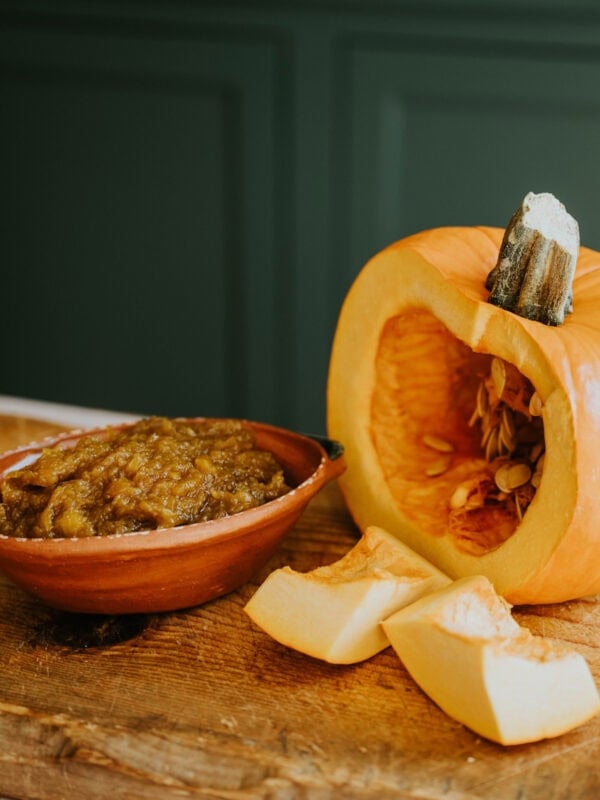
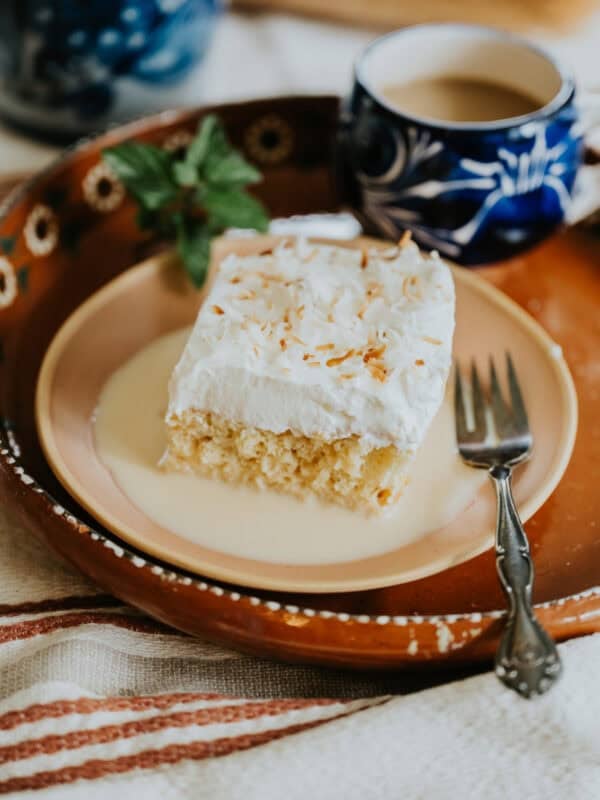










I love this recipe! It is sopt on for my aunt Yvonne’s soapapillas from my childhood. It’s a very comforting memory for me. Thank you so much for sharing!
Very simple and delicious.
YVETTE!!! I love love love your recipe, I have made these one time before, but I couldn’t get them to really puff. But this time around they puffed and I finally figured it out dropped the dough in and as soon as they started to puff I flipped it and it caught up with the other side to a golden brown and came out delicious. Thank you
These are the sopapillas that I eat at my favorite restaurants here in NM! If you can taste yeast, someone didn’t learn from their abuela.
Love this recipe.., actually love all your recipes, even have your book. I’m a visual type person, the pics are great.
Double check your info on canola oil, my sources tell me it’s pretty bad for you. Avocado oil or even lard may be healthier.
Well let me tell you! I haven’t found a better recipe than yours in the internet. Your description and detail has sold me your recipe. I have saved it. Possibly to make them tomorrow. Thank you for you inthuiasum! Happy to take the time to read your article.